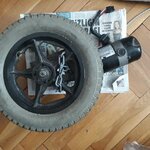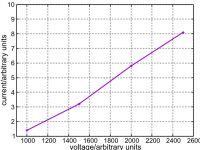anotherbrick
Full Member level 4
- Joined
- Jan 10, 2009
- Messages
- 217
- Helped
- 1
- Reputation
- 2
- Reaction score
- 1
- Trophy points
- 1,298
- Location
- Istanbul , Turkey
- Activity points
- 3,143
hello dear forum,
I am applying different PWM values to a 24 V brush DC motor
and taking some measurements of armature current,
becouse I want to calculate armature resistance
however the armature resistance is changing with applied PWM
here is what I measured;
PWM | current | internal resistance
-------------------------------------------------
1000 | 1.4 | 710
1500 | 3.2 | 470
2000 | 5.8 | 350
2500 | 8.1 | 310
I assumed the applied voltage is linearly changing with applied PWM
and locked the motor shaft and calculated a number which must be the
internal resistance multiplied with a constant
I used the equation PWM = I x R (resistance x constant)
my question ;
why is the number representing the internal resistance not a constant ?
my aim was to calculate the motor speed from the equation
V = EMF + I x R
however I got a changing resistance value and I couldnot calculate the speed
please advice
thank you
I am applying different PWM values to a 24 V brush DC motor
and taking some measurements of armature current,
becouse I want to calculate armature resistance
however the armature resistance is changing with applied PWM
here is what I measured;
PWM | current | internal resistance
-------------------------------------------------
1000 | 1.4 | 710
1500 | 3.2 | 470
2000 | 5.8 | 350
2500 | 8.1 | 310
I assumed the applied voltage is linearly changing with applied PWM
and locked the motor shaft and calculated a number which must be the
internal resistance multiplied with a constant
I used the equation PWM = I x R (resistance x constant)
my question ;
why is the number representing the internal resistance not a constant ?
my aim was to calculate the motor speed from the equation
V = EMF + I x R
however I got a changing resistance value and I couldnot calculate the speed
please advice
thank you


